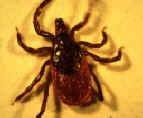Transmission
Both ehrlichiosis and anaplasmosis are transmitted by the bite of an infected tick. The most important carriers of anaplasmosis in the United States are the western blacklegged tick and the deer tick, both of which also transmit Lyme disease. HME is transmitted by the lone star tick and possibly other species.
|

|

|

|
|
Western Blacklegged Tick
|
Lone Star Tick
|
Deer Tick |
Photo Credits:
The western blacklegged tick and lone star tick photos are courtesy of the Centers for Disease Control and Prevention.
The deer tick photo is courtesy of NIAID.